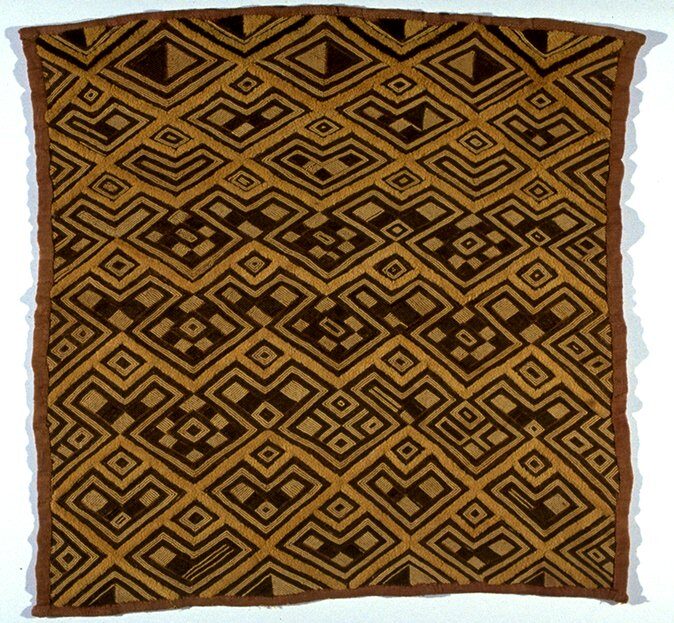Raffia Textile Panel
Kuba

Description
March 28, 2009
Kuba artists apply their bold and sophisticated surface design to ceremonial and everyday objects alike. One of the most impressive expressions of this aesthetic tradition is cloth made from raffia fiber, a hardy and ubiquitous material that in Kuba thought symbolizes abundance and wealth. Decorated raffia cloth was used as currency and for public display at events such as the funerals of high-ranking titleholders—a practice that continues today. Men weave the base cloth, and women design, dye, and embroider it. Cloth designs are named, often after the women who created them, but in this case the name of the design is not known. Produced also for the international market, Kuba cloth—and imitations of its designs—can be found in shops and private collections around the world.
This cut-pile raffia cloth is typical of those made by the Shoowa, a Kuba subgroup. In cloth made for their own use, the Shoowa used an overall balanced pattern, a deep plush, and even lines. In cloth like this one, produced for the external market, artists juxtaposed different patterns and varied the fill-in designs.
Subject Matter:
The Kuba peoples are renowned for their elaborate, geometrical surface design, such as applied to this cloth. Also referred to as cut pile, raffia cloth, Shoowa textile or Kasai velvet (Velours du Kaisai), Kuba cloth is often made from barkcloth: a felt fabric, typically not classified as a textile because it is not woven. Their plush “velvet” texture is achieved through the cut pile technique, where a sharp knife is used to gently clip off the tufts of the palm thread.
In the 19th century, decorated raffia cloth was used as a marker of prestige, as currency, to pay tribute, settle legal disputes, and in public displays such as the funerals of high-ranking titleholders. Additionally, they were often used as initiation objects during ceremonial rites of passage. Though barkcloth is the typical fabric, recently industrial cloth has been used as a replacement.
The textiles are generally covered with geometric patterns, similar to patterns found on Kuba basketry, woodwork, sculpture, and female body scarifications. Patterns may be given names, but the same pattern will likely be given a different name by different people.
The diamond pattern in this cloth is created through a repetitive crossing of lines and positioning of chevrons opposite to one another. A double crossing can possibly be considered a reference to Woot, the mythical founder of the Kuba, whose mother invented mat weaving.
References:
Roy Sieber, African Textiles and Decorative arts, 1972
Georges Meurant, African Textiles from the Kingdom of Kuba, 1986
Daniel Biebuyck, The Arts of Zaire, 1985
Monni Adams, Kuba Embroidered Cloth, 1978
Physical Description:
Square panel consisting of intersecting light brown lines and dark brown chevrons to form a diamond pattern grid. The edges of the panel are hemmed.
Usage Rights:
If you are interested in using an image for a publication, please visit https://umma.umich.edu/request-image/ for more information and to fill out the online Image Rights and Reproductions Request Form.